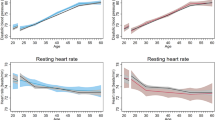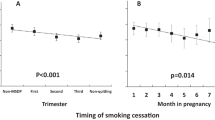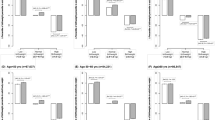Abstract
Objective
Understanding the natural history of hypertension is key to identifying prevention strategies. Previous work suggests that in utero exposures and offspring anthropometrics may play a role. This study examined the relationship between maternal pre-pregnancy body mass index (BMI) and the mediating role of childhood and adolescent BMI on offspring blood pressure at 18 years.
Methods
We performed multivariable regression and causal mediation analyses within 3217 mother - offspring pairs from the Avon Longitudinal Study of Parents and Children prospective birth cohort. The main exposure was maternal pre-pregnancy BMI, and the outcome was offspring blood pressure at 18 years of age categorized as normal or elevated. Latent trajectory analysis was used to quantify the mediator, offspring BMI trajectories, derived from multiple measurements throughout childhood and adolescence. Mediation analyses were repeated using current offspring BMI at 18 years as a continuous variable.
Results
Multivariable logistic regression revealed that for every 1 unit increase in maternal BMI, the risk of elevated blood pressure at 18 years of age increased by 5% (aOR: 1.05, 95% CI: 1.03–1.07; p < 0.001). The strength of this association was reduced after adjusting for offspring BMI trajectory (aOR: 1.03, 95% CI: 1.00–1.05; p = 0.017) and eliminated after adjusting for offspring BMI at 18 years (aOR: 1.00; 95% CI: 0.98–1.03; p = 0.70). Causal mediation analysis confirmed offspring BMI at 18 years as a mediator, where BMI trajectory accounted for 46% of the total effect of maternal BMI on elevated offspring blood pressure and current BMI account for nearly the entire effect.
Conclusions
Maternal pre-pregnancy BMI is associated with an increased risk of elevated blood pressure in offspring at 18 years of age although it appears to be entirely mediated by offspring BMI.
This is a preview of subscription content, access via your institution
Access options
Subscribe to this journal
Receive 12 print issues and online access
$259.00 per year
only $21.58 per issue
Buy this article
- Purchase on Springer Link
- Instant access to full article PDF
Prices may be subject to local taxes which are calculated during checkout



Similar content being viewed by others
Code availability
All R code used to generate latent trajectory analysis and causal mediation analyses are available in Appendix B.
References
Sharma AK, Metzger DL, Rodd CJ. Prevalence and severity of high blood pressure among children based on the 2017 American Academy of Pediatrics Guidelines. JAMA Pediatr. 2018;172:557–65.
Yang L, Magnussen CG, Yang L, Bovet P, Xi B. Elevated blood pressure in childhood or adolescence and cardiovascular outcomes in adulthood: a systematic review. Hypertension. 2020;75:948–55.
Sundström J, Neovius M, Tynelius P, Rasmussen F. Association of blood pressure in late adolescence with subsequent mortality: cohort study of Swedish male conscripts. BMJ. 2011;342:d643.
Gray L, Lee I-M, Sesso HD, Batty GD. Blood pressure in early adulthood, hypertension in middle age, and future cardiovascular disease mortality: HAHS (Harvard Alumni Health Study). J Am College Cardiol. 2011;58:2396–403.
Leiba A, Fishman B, Twig G, Gilad D, Derazne E, Shamiss A, et al. Association of adolescent hypertension with future end-stage renal disease. JAMA Internal Med. 2019;179:517–23.
Sundin P-O, Udumyan R, Sjöström P, Montgomery S. Predictors in adolescence of ESRD in middle-aged men. Am J Kidney Dis. 2014;64:723–9.
Fleming TP, Watkins AJ, Velazquez MA, Mathers JC, Prentice AM, Stephenson J, et al. Origins of lifetime health around the time of conception: causes and consequences. Lancet. 2018;391:1842–52.
Ravelli GP, Stein ZA, Susser MW. Obesity in young men after famine exposure in utero and early infancy. N Engl J Med. 1976;295:349–53.
Roseboom T, de Rooij S, Painter R. The Dutch famine and its long-term consequences for adult health. Early Hum Dev. 2006;82:485–91.
Chiefari E, Arcidiacono B, Foti D, Brunetti A. Gestational diabetes mellitus: an updated overview. J Endocrinol Invest. 2017;40:899–909.
Reynolds RM, Allan KM, Raja EA, Bhattacharya S, McNeill G, Hannaford PC, et al. Maternal obesity during pregnancy and premature mortality from cardiovascular event in adult offspring: follow-up of 1 323 275 person years. BMJ. 2013;347:f4539.
Chen C, Xu X, Yan Y. Estimated global overweight and obesity burden in pregnant women based on panel data model. PLoS One. 2018;13:e0202183.
Ludwig-Walz H, Schmidt M, Gunther ALB, Kroke A. Maternal prepregnancy BMI or weight and offspring’s blood pressure: Systematic review. Matern Child Nutr. 2018;14:e12561.
Ahanchi NS, Ramezankhani A, Munthali RJ, Asgari S, Azizi F, Hadaegh F. Body mass index trajectories from adolescent to young adult for incident high blood pressure and high plasma glucose. PLoS One. 2019;14:e0213828.
Boyd A, Golding J, Macleod J, Lawlor DA, Fraser A, Henderson J, et al. Cohort profile: the ‘children of the 90 s’–the index offspring of the avon longitudinal study of parents and children. Int J Epidemiol. 2013;42:111–27.
Fraser A, Macdonald-Wallis C, Tilling K, Boyd A, Golding J, Davey Smith G, et al. Cohort profile: the avon longitudinal study of parents and children: ALSPAC mothers cohort. Int J Epidemiol. 2012;42:97–110.
Northstone K, Lewcock M, Groom A, Boyd A, Macleod J, Timpson N, et al. The Avon Longitudinal Study of Parents and Children (ALSPAC): an update on the enrolled sample of index children in 2019. Wellcome Open Res. 2019;4:51.
Sharp GC, Lawlor DA, Richmond RC, Fraser A, Simpkin A, Suderman M, et al. Maternal pre-pregnancy BMI and gestational weight gain, offspring DNA methylation and later offspring adiposity: findings from the Avon Longitudinal Study of Parents and Children. Int J Epidemiol. 2015;44:1288–304.
Flynn JT, Kaelber DC, Baker-Smith CM, Blowey D, Carroll AE, Daniels SR, et al. Clinical practice guideline for screening and management of high blood pressure in children and adolescents. Pediatrics. 2017;140:e20171904.
Collins LM, Lanza ST Latent class and latent transition analysis: with applications in the social, behavioral, and health sciences: John Wiley & Sons; 2009 Dec 14.
Proust-Lima C, Philipps V, Liquet B Estimation of extended mixed models using latent classes and latent processes: the R package lcmm. arXiv preprint arXiv:1503.00890. 2015 Mar 3.
Cooke C-LM, Davidge ST. Advanced maternal age and the impact on maternal and offspring cardiovascular health. Am J Physiol-Heart Circulatory Physiol. 2019;317:H387–H94.
Taal HR, de Jonge LL, van Osch-Gevers L, Steegers EA, Hofman A, Helbing WA, et al. Parental smoking during pregnancy and cardiovascular structures and function in childhood: the Generation R Study. Int J Epidemiol. 2013;42:1371–80.
Kivimäki M, Lawlor DA, Smith GD, Keltikangas-Järvinen L, Elovainio M, Vahtera J, et al. Early socioeconomic position and blood pressure in childhood and adulthood: the Cardiovascular Risk in Young Finns Study. Hypertension. 2006;47:39–44.
Zanetti D, Tikkanen E, Gustafsson S, Priest JR, Burgess S, Ingelsson E. Birthweight, type 2 diabetes mellitus, and cardiovascular disease: addressing the barker hypothesis with mendelian randomization. circulation: genomic and precision. Medicine. 2018;11:e002054.
Huxley R, Neil A, Collins R. Unravelling the fetal origins hypothesis: is there really an inverse association between birthweight and subsequent blood pressure? The Lancet. 2002;360:659–65.
Tu Y-K, Ellison GT, Gilthorpe MS. Growth, current size and the role of the’reversal paradox’in the foetal origins of adult disease: an illustration using vector geometry. Epidemiol Perspect Innovat. 2006;3:1–10.
Steen J, Loeys T, Moerkerke B, Vansteelandt S. medflex: an R package for flexible mediation analysis using natural effect models. J Stat Softw. 2017;1:2017.
Steen J, Loeys T, Moerkerke B, Vansteelandt S. Flexible mediation analysis with multiple mediators. Am J Epidemiol. 2017;186:184–93.
Smith LH, VanderWeele TJ. Mediational E-values: approximate sensitivity analysis for unmeasured mediator–outcome confounding. Epidemiology. 2019;30:835.
Agarwal P, Morriseau TS, Kereliuk SM, Doucette CA, Wicklow BA, Dolinsky VW. Maternal obesity, diabetes during pregnancy and epigenetic mechanisms that influence the developmental origins of cardiometabolic disease in the offspring. Crit Rev Clin Lab Sci. 2018;55:71–101.
Cox B, Luyten LJ, Dockx Y, Provost E, Madhloum N, De Boever P, et al. Association between maternal prepregnancy body mass index and anthropometric parameters, blood pressure, and retinal microvasculature in children age 4 to 6 years. JAMA Netw Open. 2020;3:e204662.
Fraser A, Tilling K, Macdonald-Wallis C, Sattar N, Brion MJ, Benfield L, et al. Association of maternal weight gain in pregnancy with offspring obesity and metabolic and vascular traits in childhood. Circulation. 2010;121:2557–64.
Aris IM, Rifas-Shiman SL, Li LJ, Belfort MB, Hivert MF, Oken E. Early-life predictors of systolic blood pressure trajectories from infancy to adolescence: findings from project viva. Am J Epidemiol. 2019;188:1913–22.
Dangardt F, Charakida M, Georgiopoulos G, Chiesa ST, Rapala A, Wade KH, et al. Association between fat mass through adolescence and arterial stiffness: a population-based study from The Avon Longitudinal Study of Parents and Children. The Lancet Child Adolescent Health. 2019;3:474–81.
Yu E, Ley SH, Manson JE, Willett W, Satija A, Hu FB, et al. Weight history and all-cause and cause-specific mortality in three prospective cohort studies. Ann Intern Med. 2017;166:613–20.
Xu H, Cupples LA, Stokes A, Liu CT. Association of obesity with mortality over 24 years of weight history: findings from the framingham heart study. JAMA Netw Open. 2018;1:e184587.
Hu Z, Tylavsky FA, Han JC, Kocak M, Fowke JH, Davis RL, et al. Maternal metabolic factors during pregnancy predict early childhood growth trajectories and obesity risk: the CANDLE Study. Int J Obes. 2019;43:1914–22.
Montazeri P, Vrijheid M, Martinez D, Basterrechea M, Fernandez-Somoano A, Guxens M, et al. Maternal metabolic health parameters during pregnancy in relation to early childhood BMI trajectories. Obesity (Silver Spring). 2018;26:588–96.
Staley JR, Bradley J, Silverwood RJ, Howe LD, Tilling K, Lawlor DA, et al. Associations of blood pressure in pregnancy with offspring blood pressure trajectories during childhood and adolescence: findings from a prospective study. J Am Heart Assoc. 2015;4:e001422
Hammoud NM, Visser GHA, van Rossem L, Biesma DH, Wit JM, de Valk HW. Long-term BMI and growth profiles in offspring of women with gestational diabetes. Diabetologia. 2018;61:1037–45.
Acknowledgements
We are extremely grateful to all the families who took part in the ALSPAC study, the midwives for their help in recruiting them, and the whole ALSPAC team, which includes interviewers, computer and laboratory technicians, clerical workers, research scientists, volunteers, managers, receptionists, and nurses.
Funding
The UK Medical Research Council and Wellcome (Grant ref: 217065/Z/19/Z) and the University of Bristol provide core support for ALSPAC. A comprehensive list of grants funding is available on the ALSPAC website (http://www.bristol.ac.uk/alspac/external/documents/grant-acknowledgements.pdf). JMM was supported by a Canadian Institutes of Health Research (CIHR) Applied Public Health Chair, MBA holds a Tier 2 Canada Research Chair (CRC) in the Developmental Origins of Chronic Disease. JMM holds grants from the CIHR, Diabetes Canada, the Heart and Stroke Foundation of Canada (HSFC), the Cosmopolitan Foundation, and the Lawson Foundation. AD currently has research funding from CIHR, Research Manitoba and CHRIM. MBA holds grants from the CIHR, The Bill and Melinda Gates Foundation, the Canada Foundation for Innovation, the Garfield G. Weston Foundation, Prolacta Biosciences, Mitacs, the Canadian Institutes for Advanced Research, the Children’s Hospital Foundation of Manitoba, and Research Manitoba; NB and JMM, MBA and AD were also supported by a Research Manitoba grant to the DEVOTION research cluster. None of the cited agencies were involved in the design, conduct, or approval of this manuscript.
Author information
Authors and Affiliations
Contributions
NB, BD and JMM: Designed and conceptualized the study. BD and NB performed the analyses. MA: Designed and conceptualized the study, was involved in securing funding, reviewed and revised the manuscript. AD: Designed and conceptualized the study was involved in securing funding, reviewed and revised the manuscript. JMC and NB take full responsibility for the analyses and content presented in this manuscript.
Corresponding author
Ethics declarations
Competing interests
The authors declare no competing interests.
Additional information
Publisher’s note Springer Nature remains neutral with regard to jurisdictional claims in published maps and institutional affiliations.
Supplementary information
Rights and permissions
About this article
Cite this article
Brunton, N.M., Dufault, B., Dart, A. et al. Maternal body mass index, offspring body mass index, and blood pressure at 18 years: a causal mediation analysis. Int J Obes 45, 2532–2538 (2021). https://doi.org/10.1038/s41366-021-00930-2
Received:
Revised:
Accepted:
Published:
Issue Date:
DOI: https://doi.org/10.1038/s41366-021-00930-2



